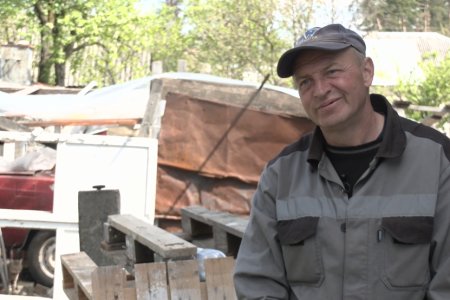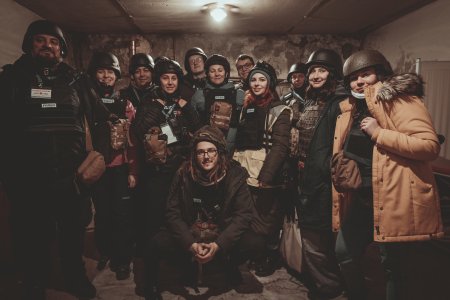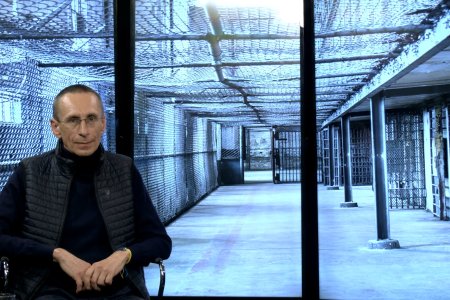Why is the book “Voices of War. Mariupol” vital to you?
This book is vital for me as a human and Ukrainian because the history of Mariupol is our shared history. The record is harrowing. I understand we cannot react the same way the people there actually reacted. But still, I remember the effect of these events. It so happened that I was doing a whole series of “The Thin Red Line”, which I dedicated to the events in Mariupol. Since 24 February, something has been happening all the time. It seems to me that this is my small contribution to the common cause. I saw people whose voices sounded in this book I read. It was terrifying.
![© Денис Волоха / Харківська правозахисна група [матвій вайсберг]](https://khpg.org/files/img/1608818198.jpg)
How much did the war affect your work?
The war, in general, influenced my work. I started painting at the beginning of March last year, right away. Not everyone did it that way because people have different nervous systems. I have known mine from the experience in 2014 when I painted “The Wall” — the wall of the Maidan [1]. I just started drawing, and it saved me. I saved myself later with my travel diary.
On the other hand, it seemed to me that people were waiting for these works of mine. It was important for someone, and I was told about it later. The work was nervous: every day, I drew something, and even if it were trees, it was still about the war.
![© Матвій Вайсберг / Flickr [маріуполь thin red line тонка червона лінія]](https://khpg.org/files/img/1608818194.jpg)
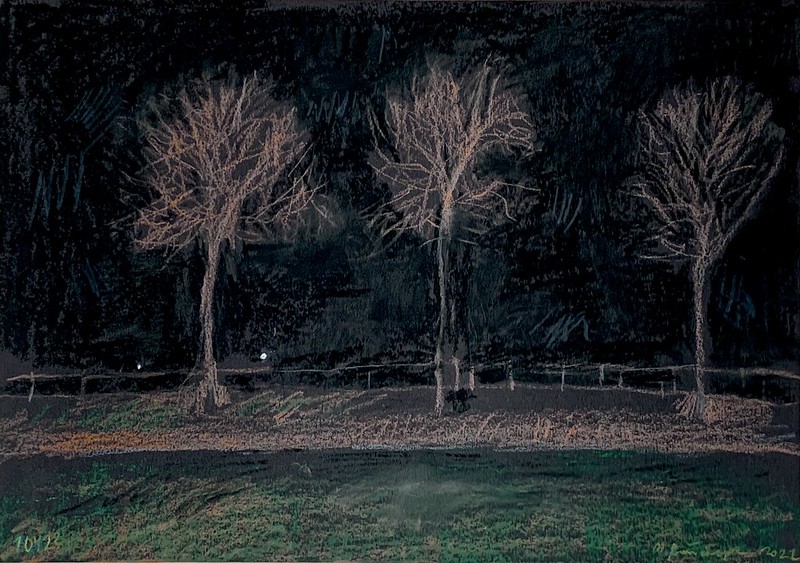
I do not remember such volume of work or exhibition activity as during these last 512-513 days. So many auctions, charity work, and so on. Except perhaps in youth. Such amazing things happened as, for example, an exhibition of the Diary in The Hague in the Ministry of Justice. Many things happened, and I can’t list them all now. I made huge murals in Babi Yar [the site of a mass grave of Nazi victims, mostly Jews]. Maybe you saw it, I don’t know. I also painted “Angel of the Armed Forces of Ukraine”, “Menorah”, and so on. Several books have been published. “Road Diary”, the book you [KHPG] published. There should be another book out. Some of my work is used — it means that I am needed and useful. Obviously, almost all such work is done on a volunteer basis.
There was also a very peculiar exhibition at the Venice Biennale featuring “Artists who paint after February 24th”. As a rule, participation in it is such a closed club that I didn’t go there. And it was also about the war and our events.
Artists do react differently to dramatic events. Some get frustrated...
Well, I’ll tell you that you can’t blame anyone here. Everyone’s nervous system is different. Some people just went to fight. People like artists and others: An artist is the same person, man or woman, as other people. Some did purely volunteer work, and others, like my friends and me, started to paint, and that’s fine.
In the beginning, it was work every day. Now I allow myself to [rest] a little. It was physical fatigue after these huge murals, 120 m², and I finished them in 8 or 10 days. I never thought I’d be doing this. My Lithuanian friend brought the “Journey of Moses” exhibition, and we exhibited together at Babi Yar. If I’m not mistaken, this was the first international exhibition since the beginning of the war in the sense that “they brought their art to us”.
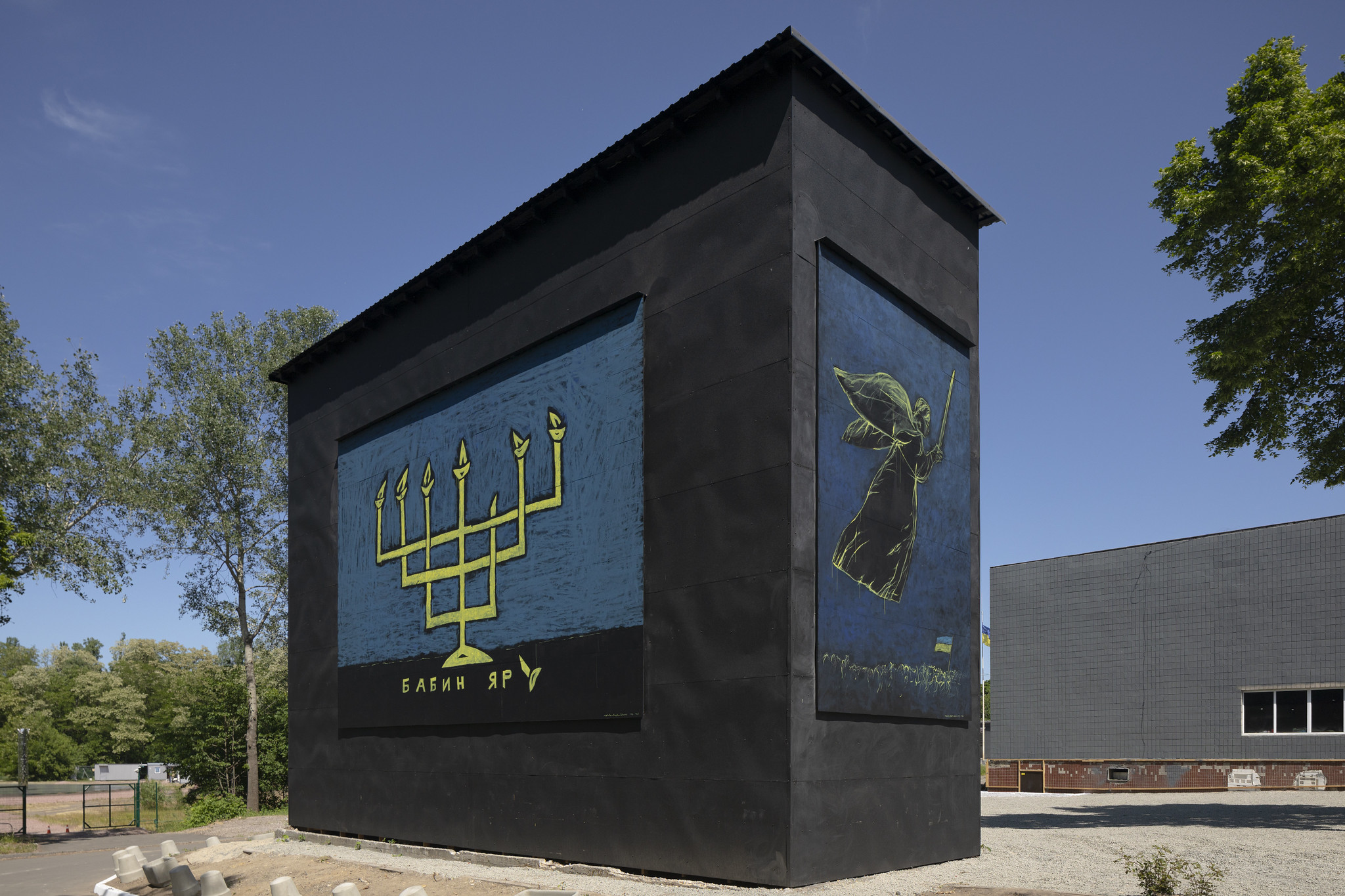
There was also such a series, which I forgot to mention, “Caravan”. It was dedicated to the grain and bread caravan. I went to Odessa and did not think to paint the sea at all. Why would I paint it? But suddenly, I saw ships on the horizon. Then, a completely different story with this Caravan came out. Maybe I will continue it somehow, now it is especially important.
![Караван, 2022. © Матвій Вайсберг / Flickr [одеса караван]](https://khpg.org/files/img/1608818203.jpg)
![© Матвій Вайсберг / Flickr [одеса караван]](https://khpg.org/files/img/1608818197.jpg)
What works of Ukrainian artists during the war struck you personally? If there is any.
There are some, and these are the works of my artist friends. Akhry Adzhynzhal works. Olena Preduvalova. Oleksii Apollonov. Sieva Sharko. There are many artworks, and it’s hard to list them all as many people are working now. Katia Lisova is a discovery in general — a person who does exciting things.
Slavik Shereshevskyi produces a lot about the war. There is some powerful work there. They are a little ironic: the work, where he looks at the sinking cruiser “Moskva”. Moreover, the cruiser at that time had not yet sunk. Well, I painted it drowned even earlier in my “Road Diary”.
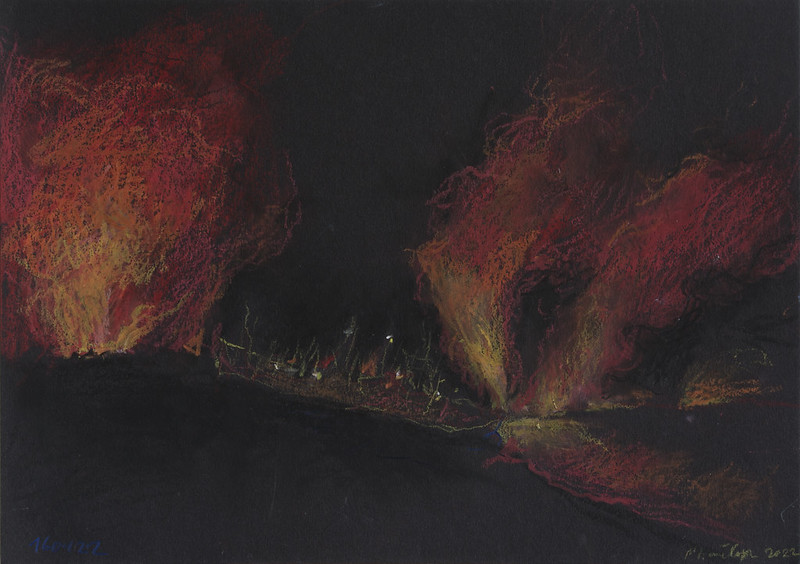
Separately, I want to say about the work of Sasha Zhyvotkov. Powerful work. He has a unique author technique, and I don’t even know what to call it — in sculpture and painting. Strong and, I would say, poignant was the exhibition at the Ukrainian House.
What was your most emotionally exhausting work during this time?
Probably “Road Diary”, because I set myself the task of drawing a small picture daily — they are all in A4 format. It was necessary to respond to the current conditions. And how should I react to them if I was in it? It was a vast and, I think, significant work. For me, perhaps the most critical thing by and large.
In general, it isn’t easy to single out one thing. Drawing, especially now, is hugely exhausting because everything has to be honest. At such times, half-heartedly doing something will not work.
Now, there is a lot of talk about the fact that the state allocates 28 million UAH [Ukranian currency] to replace the hammer and sickle in the Motherland [sculpture] with a trident, for which Ukrainians voted in “Diya” [survey app]. How do you feel about this decision?
Is it normal for her to stand with a hammer and sickle? It is an amusing story with this, as we called her, dame. But you know, it’s like those terrible structures that Omelchenko [2] installed on the Maidan: they became history after there was the Maidan. A new hype about the Odesa museum started yesterday or the day before — you need to buy drones and not invest in museums. Well, it’s obvious we need drones. But it is also necessary to invest in something else, if there is such an opportunity, in art. Otherwise, we can fail.
“Our culture has been appropriated by Russia”
It is not in vain that the aggressor country spends hundreds, tens of millions of dollars on all this. I’ve seen these exhibitions of theirs — terrible. I can’t hear such a phrase as the Russian avant-garde. It was appropriated. But we have things… First, Malevych is ours, anyway. Secondly, such phenomena as Boichukizm [3], etc., are universally significant, and money must be invested in developing them and modern culture. When the museums began to invite various Western institutions, for example, the Louvre asked the Khanenko Museum, and they brought a Byzantine icon. And nothing would be wrong if they got modern Ukrainian authors along with the Byzantine icon. I say this as an interested person, first of all. And secondly, this is how it is done all over the world. I have seen many such exhibitions designed to show a connection of times. Our modern culture with traditional roots deserves to be shown to the world now. It is evident, even based on my little experience.
![Стіна, 2014. © Матвій Вайсберг / Flickr [майдан]](https://khpg.org/files/img/1608818204.jpg)
You know, like an exhibition in The Hague or somewhere else. It worked when my “Wall” was shown in the Polish Sejm. And the state should take care of it. But, unfortunately, we do not have such a tradition. I do not want to name names — a thankless task. Although I know what I’m talking about. They [government officials] just don’t understand why it’s necessary. And this is necessary. This is the entrance to another club. The world travels to exhibitions, and the world watches works of art. There, the attitude towards people who love or engage in art differs from ours. Eventually, Ukraine will cease; it is already ceasing to be a cartoon country. Finally, Ukraine began to exist as a cultural entity in the world, which needs to be supported by the state at the state level.
You walk these streets every day. Does urban space aggravate you as an artist?
I have been painting the sky in this workshop for twenty years. I have been drawing the sky through the window for twenty years, and you can see what is there now. I don’t know if those houses will be inhabited. Sophia of Kyiv [4] was visible from here. These constructions are terrible, and I think it continues from the Soviet government, but not to such an extent. The late mayor Omelchenko, not the late mayor Lenya Kosmos [Leonid Chernovetskyi], was especially distinguished by this. Well, Lenya Kosmos just came as a marauder. Omelchenko did everything before — built this “pyramid”. And now it continues.
![© Денис Волоха / Харківська правозахисна група [матвій вайсберг]](https://khpg.org/files/img/1608818205.jpg)
What can I say... If you ask about such things, I participated in many actions, but we did not manage to save anything — neither the Senny market nor the art workshop on Andreevsky Spusk, and so on. They [government officials] are all greedy. As they say in Odessa, greed is the mother of all vices.
Esquire magazine had a “Rules of Life” column. What are the rules of life for Matvii Vaisberg?
I have several principles.
Are these the rules of life?
Probably yes. Let’s say I never sell myself, as I have already said. Never. But the second principle is somewhat contrary to the first — I don’t run away from offers. I do not offer, but I do not run away from them. Do what you can do and live as you live. Live right, if possible, and do the right thing. What other rules could there be?
![© Матвій Вайсберг / Flickr [маріуполь thin red line тонка червона лінія]](https://khpg.org/files/img/1608818195.jpg)
You know, there is a fable about how two Jewish wise men met; it seems to be around from the 7th century. And one says to the other: “Explain to me the essence of Judaism while I stand on one leg.” (I must admit I am not a believer.) So, the other says: “Easy! Do not do to others what you would not want them to do to you.” That’s all. Such a rule. Fundamental.
The book “Voices of War. Mariupol” with paintings by Matvei Vaisberg and photographs by Yevgeny Sosnovsky, can be purchased at Knyharnia “Ye” and directly from the Kharkiv Human Rights Group.
[1] Maidan Nezalezhnosti is the central square of Kyiv, the capital city of Ukraine. Maidan Revolution in February 2014 culminated in the ousting of elected President Viktor Yanukovych and a return to the 2004 Constitution. It also led to the outbreak of the Russo-Ukrainian War.
[2] Oleksandr Oleksandrovych Omelchenko was a Ukrainian politician who served as mayor of Kyiv, first elected in 1999.
[3] Boichukism is a cultural and artistic phenomenon in the history of Ukrainian art between the 1910s and 1930s, distinguished by its artistic monumental-synthetic style.
[4] Saint Sophia Cathedral is an ancient (11 century) architectural monument of Kievan Rus.
